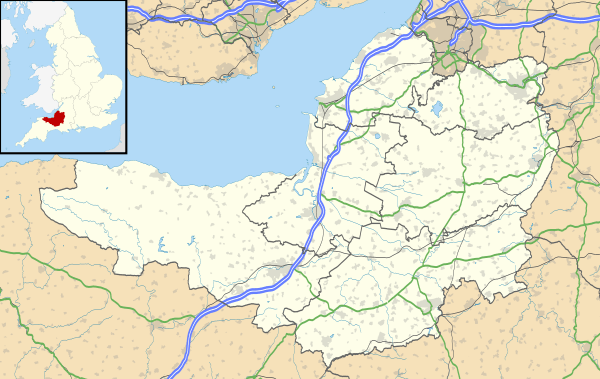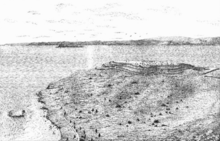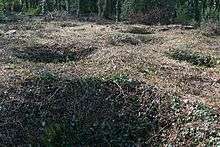Worlebury Camp
Worlebury Camp (also known as Worlebury Hillfort) is the site of an Iron Age hillfort on Worlebury Hill, north of Weston-super-Mare in Somerset, England. The fort was designed for defence, as is evidenced by the number of walls and ditches around the site. Several large triangular platforms have been uncovered around the sides of the fort, lower down on the hillside. Nearly one hundred storage pits of various sizes were cut into the bedrock, and many of these had human remains, coins, and other artefacts in them.[2] During the 19th and 20th centuries the fort has suffered damage and been threatened with complete destruction on multiple occasions. The site has been designated a Scheduled monument;[1][3] it falls within the Weston Woods Local Nature Reserve which was declared to Natural England by North Somerset Council in 2005.[4]
| Worlebury Camp | |
|---|---|
 A picture of the present-day site | |
| Location | North Somerset, Somerset, England |
| Coordinates | 51°21′26.73″N 2°59′6.55″W |
| Built | During the Iron Age |
| Architectural style(s) | British pre-Roman Architecture |
| Official name: Worlebury Camp | |
| Reference no. | 22841[1] |
 Worlebury Camp shown within Somerset | |
History
In The Ancient Entrenchments and Camps of Gloucestershire, Edward J. Burrow mentions that probably either the Goidel or Brython people initially built Worlebury Camp.[5] The Belgae people subsequently overthrew the initial inhabitants and occupied the camp for a time, but they were finally destroyed at the hands of the Romans.[6]
Worlebury Camp has been explored at various times over a period of 150 years. From 1851 to 1852, Charles Dymond, Edwin Martin Atkins, and Francis Warre excavated and surveyed Worlebury Camp.[7] Dymond returned in 1880 to continue the excavation, which lasted until 1881. Another century passed before the Woodspring Museum from Weston-super-Mare excavated more of Worlebury camp in 1987 to 1988. Finally, in 1998, the Avon Extensive Urban Study team performed the latest (as of 2008) assessment of the site.[8]
A condition survey undertaken in 2017-18 resulted in a request for an analytical earthwork survey which was undertaken by Historic England in 2018-19. This revealed some evidence about the use of the hillfort and its later history but many questions remain.[9]
Location

The fort is located on the summit of Worlebury Hill, 109 metres (358 ft) above sea level.[10] It is in the present-day North Somerset, above the seaside resort of Weston-super-Mare[8] and close to the village of Worle.[11]
Its occupants would have had a view of the countryside as well as any potential invaders. They would have been able to see out over to Sugar Loaf Mountain, the Black Mountains, the Mendip Hills, Dunkery Beacon, Sand Point, and Wales.[12] This view is no longer as unobstructed as it once was because there are so many trees spread over the hill.[13]
Archaeological findings
Platforms
There are a number of triangular platforms on the slopes around the fort. The apexes of these triangles are flush with the hillside, with the base projecting in the downhill direction. However, the upper surface is approximately level. The front faces of these platforms are about 1.7 metres (5.6 ft) above the hillside, and they have ditches in front of them to improve their defence. In a letter to Warre, Atkins theorised that the structures were slingers' platforms or archers' stations.[7] Several sling stones have been found around them, offering some credence to the theory that slingers stood upon these platforms. Dymond mentions the stones in his book:
Several of them were broken, as though they had been used in the attack [on the fort], as, indeed, many of them probably were.[7]
— Charles Dymond, Worlebury: An Ancient Stronghold in the County of Somerset
Walls and ditches

Worlebury Hill is bordered on its north and west sides by steep cliffs dropping down into the Bristol Channel between Weston Bay and Sand Bay.[14] These would have rendered the fort nearly invulnerable to attack from those directions.[2][15] Nevertheless, the fort still has one wall on its north side and one on its west side, both very near the edge of the cliffs. On the south side, a single rampart and a ditch guarded the fort. The level east side was protected by two stone ramparts and five ditches.[7] Parts of these ramparts were over 11 metres (35 ft) high measuring from the bottom of the ditch as of 1875.[16]
The walls themselves are around 1 metre (3.3 ft) thick. However, because they are dry-laid stone, the removal of a few stones would be sufficient to bring the entire wall collapsing down. To prevent access to the walls themselves, the inhabitants of the fort raised large breastworks around the base of the walls by piling up rock rubble against the bases. These rubble barriers are over 1.22 metres (4.0 ft) high, and in places they are over 1.22 metres (4.0 ft) thick. Attackers would have had to clear away the rubble before being able to attack the wall, and all the while they would be under direct fire from defenders on the top of the wall.[7]
Storage pits

The area inside the outer wall has a series of hut circles and 93 storage pits cut directly into the bedrock, which is only around 60 centimetres (2.0 ft) beneath the surface of the soil in most places. Eighteen of the Storage pits are in what Dymond calls the "keep", one is in the transverse fosse (a fosse is a ditch usually dug for protection[17]), and seventy-four of the pits are outside the "keep" but still enclosed within the exterior walls. The average size of the pits is around 2 metres (6.6 ft) long by 2 metres wide and 1.5 metres (4.9 ft) deep. The largest pit is roughly triangular, with sides measuring 3 metres (9.8 ft), 2.7 metres (8.9 ft), and 2.4 metres (7.9 ft) long. The smallest pit is 1 metre (3.3 ft) long by .7 metres (2.3 ft) wide.[7] The inhabitants used them to store grain, as is evidenced by the kernels of barley and wheat and the shards of pots that were found in the pits. Several of the pits contained the remnants of peas and the remains of burned woven baskets. In addition, researchers also found sling stones and spindle whorls dated to the 1st or 2nd century BC in them.[7][8]
Eighteen of these pits were found to contain the remains of human skeletons, which are now stored in the Weston-super-Mare Museum in Weston-super-Mare.[15] Eighteen full skeletons were found, of which ten show evidence of a violent death (including sword cuts in the skulls).[18][19] It is possible that the Romans or the Belgic raiders attacked the fort and killed the inhabitants.[2]
Artefacts
A cast copper alloy penannular collar of special interest to archaeologists has been found at the campsite. It may indicate that this hilltop site was used even before the Iron Age, since related artefacts tend to be found with Bronze Age items, and it was the first of its type found in Britain.[1] In 2006, a related copper penannular brooch dating to the 5th or 6th century AD was found in a spring between Brecon Beacons and the Black Mountains in Wales. A gold penannular bracelet was found in the Perry River.[20]
Roman coins have been found at Worlebury Camp since the Romans had established a presence by the end of the 1st century AD.[21] Many of the Roman coins bear the image of the Western Roman Emperor Honorius. This was inside the fort proper. Another coin was located by Trinity Path which leads towards the fort.[1]
Other findings at the site include animal remains, including the bones of pigs, oxen, horses, deer, goats, and even small birds. Limpet shells have also been found near the bones. Archaeologists found iron objects, adding further credibility to the idea that this fort is from the Iron Age. These objects include a chisel or borer, several spearheads and javelin heads, and an iron cone with charred wood inside and a rivet hole through the cone. Dymond assumes that this cone was once a plowshare. Stone artefacts, mainly slingstones and scrapers, have been discovered at the site. Just less than 36 flint chips have been found, of which some may be arrowheads. One good-quality arrowhead has been found. In addition to these, Dymond recorded finding a lead lump about the size of a walnut that he decided was probably a sling bullet.[7] Glastonbury type bead-rim pottery was also found at this site.[1] A socketed bronze axe from the late Bronze Age, which was found at Worlebury Hill in 1883, is in the Ashmolean Museum.[22]
Damage to the site

19th century
Development of Weston-super-Mare since the 19th century has resulted in three episodes of potentially irreversible damage to the site. A quarry started operation in the southern side of Worlebury Hill in 1815 to mine for galena, calamine, and stone. The Bristol and Exeter Railway arrived in Weston-super-Mare in 1841, making it profitable to expand the village into a town.[1] In 1842, Weston-super-Mare became a town with the granting of the Improvement and Market Act of May 1842.[19] This act also proposed developing houses right over the brow of the hill. This would have gone straight through Worlebury Camp; however, the actual expansion never reached the site. By 1853, some development had occurred according to the proposed expansion, but it had skirted the hillfort and continued to the east.[1]
20th century
In the early 20th century, the Worlebury fort itself was damaged by boys rolling stones, including some from the walls of the fort, down the hill on which it stands. The Axbridge District of the Somerset Archaeological Society was taking steps to prevent such damage from happening again.[23]
21st Century
Some of the trees planted in the early 19th century had become very large, and their roots were growing into the archaeological structures. In 2005, the Forestry Commission gave permission for North Somerset Council to fell 300 trees to reduce the subsequent risks.[24] A member of the North Somerset Council, Christopher Richards, said: "If we had a storm up here and these trees came down, then the entire hillfort could be destroyed."[24]
The site was added to the Heritage at Risk Register in 2017, its condition noted as 'declining'.[25] A condition survey and an analytical earthwork survey revealed some evidence about the use of the hillfort and its later history but many questions remain.[26]
In 2020 the council initiated a consultation on plans to remove more "thousands" of trees to protect the remains.[27]
See also
- Archeological site
- List of hill forts in England
- List of hill forts and ancient settlements in Somerset
References
- "Desk-Based Assessment of Land Adjacent to Numbers 2–10 Upper Kewstoke Road, Weston-Super-Mare, North Somerset" (PDF). Project: PJ 195. Mercian Archaeology. Retrieved 16 October 2010.
- "Worlebury Camp". Roman-Britain.org. Archived from the original on 13 June 2010. Retrieved 5 October 2010.
- "Advice on Potential Landscape/Seascape and Visual Impacts of a Severn Barrage" (PDF). Land Use Consultants. Archived from the original (PDF) on 5 June 2014. Retrieved 29 October 2010.
- "Weston woods LNR". Natural England. Retrieved 29 October 2010.
- Burrow, E. J. (1919). The Ancient Entrenchments and Camps of Gloucestershire. Cheltemham: E.J. Burrow & Co. Ltd. p. 18.
- Palmer, L. S. (January–June 1921). "Some Early British Remains From a Mendip Cave". Journal of the Royal Anthropological Institute. Royal Anthropological Institute of Great Britain and Ireland. 51: 211–212. JSTOR 2843521. (subscription required)
- Dymond, Charles William (1886). Worlebury, an Ancient Stronghold in the County of Somerset. John Wright and Co. Printer, Stone Bridge.
- "Fortified England – Worlebury Camp". Fortified England. Retrieved 7 December 2010.
- Bowden, M (2019). "Worlebury Hillfort and the Linear Earthworks to its east, Weston-super-Mare, North Somerset: Archaeological Survey Report. Historic England Research Report 93/2019". research.historicengland.org.uk. Retrieved 15 May 2020.
- "British Hills". The UK Walking Club. Retrieved 23 October 2010.
- "Welcome to the web site of the Worlebury Residents' Association". Worlebury Residents' Association. Retrieved 6 November 2010.
- "Weston Woods". North Somerset Council. Archived from the original on 8 March 2012. Retrieved 29 October 2010.
- Satellite Map of Worlebury Camp (Web-based satellite map) (Map). 1 in = 50 ft. Cartography by Blom. Microsoft. Retrieved 6 November 2010.
- "PARISH PROFILE: Kewstoke". Origins+. Archived from the original on 15 July 2011. Retrieved 30 October 2010.
- "Worlebury Camp". Megalithic Portal. Retrieved 24 January 2010.
- Journal of the British Archaeological Association. British Archaeological Association. 1875. p. 270. Retrieved 19 December 2010.
- "Fosse". Princeton University. Retrieved 19 December 2010.
- Gerry Brooke (1 December 2009). "Footsteps into History – Worlebury". Bristol Evening Post. This is Bristol. Retrieved 29 October 2010.
- "Weston super Mare – A Brief History". Weston-super-Mare. Retrieved 19 December 2010.
- "Portable Antiques Scheme – Annual Report 2006" (PDF). Dewsbury District Metal Detecting Club. pp. 31, 73–74. Archived from the original (PDF) on 14 March 2012. Retrieved 9 November 2010. (pp. 73–74)
- Rippon, Stephen; Aalbersberg, G.; Allen, J. R. L.; Allen, S.; Cameron, N.; Gleed-Owen, C.; Davies, P.; Hamilton-Dyer, S.; Haslett, S.; Heathcote, J.; Jones, J.; Margetts, A.; Richards, D.; Shiel, N.; Smith, D.; Smith, J.; Timby, J.; Tinsley, H.; Williams, H.; Jones, Julie; Cameron, Nigel; Davies, Paul; Dobinson, Simon; Gleed-Owen, Chris; Haslett, Simon; Heathcote, Jen; Margetts, Anthony; Smith, David; Tinsley, Heather; Williams, Huw; Aalbersberg, Gerard; Hamilton-Dyer, Sheila; Timby, Jane; Shiel, Norman; Richards, David; Allen, Steven (2000). "The Romano-British Exploitation of Coastal Wetlands: Survey and Excavation on the North Somerset Levels, 1993-7" (PDF). Britannia. Society for the Promotion of Roman Studies. 31: 69–200. doi:10.2307/526920. JSTOR 526920.
- Royal haskoning. "15 Archaeology and heritage" (PDF). Bristol City Council. Retrieved 29 October 2010.
- "Committee on Ancient Earthworks and Fortified Enclosures Report on November 1909". archive.org. Retrieved 16 October 2010.
- "Trees threaten Iron Age hill fort". BBC. 12 January 2005. Retrieved 29 October 2010.
- "Worlebury Camp: a large multivallate hillfort on Worlebury Hill, Weston-Super-Mare - North Somerset (UA) | Historic England". historicengland.org.uk. Retrieved 15 May 2020.
- Bowden, M (2019). "Worlebury Hillfort and the Linear Earthworks to its east, Weston-super-Mare, North Somerset: Archaeological Survey Report. Historic England Research Report 93/2019". research.historicengland.org.uk. Retrieved 15 May 2020.
- "Trees to be cleared to preserve Somerset Iron Age fort site". BBC News. 5 February 2020. Retrieved 5 February 2020.
External links
| Wikimedia Commons has media related to Worlebury hill fort. |
- Worlebury Village Homepage
- A street map with Worlebury Camp indicated by the arrow
- A bird's-eye view of present-day Worlebury Camp
![]()